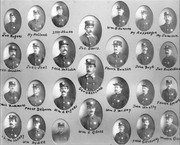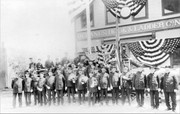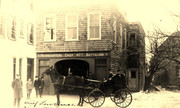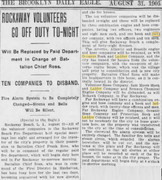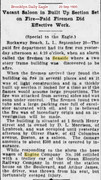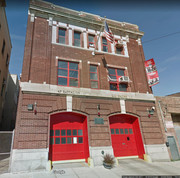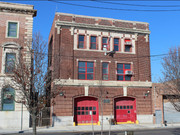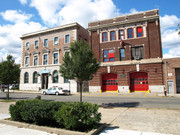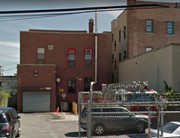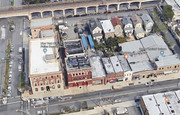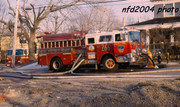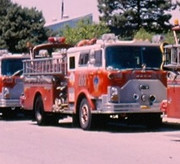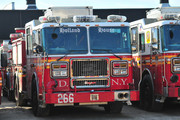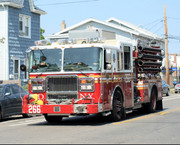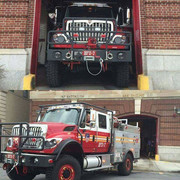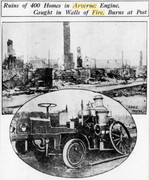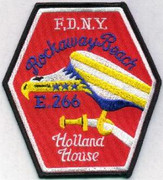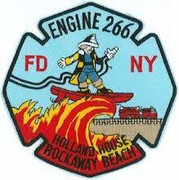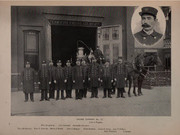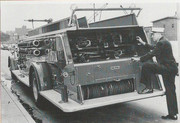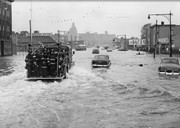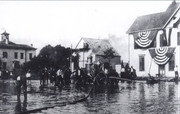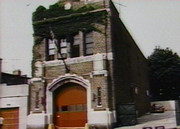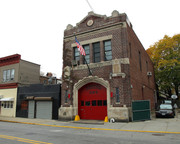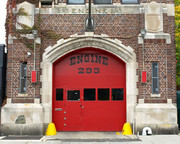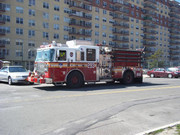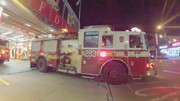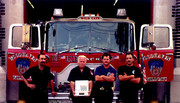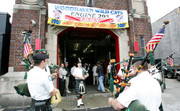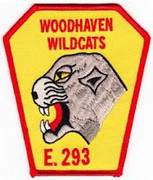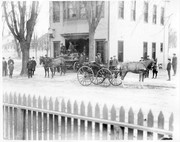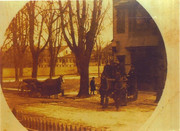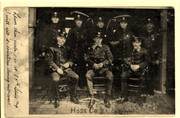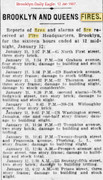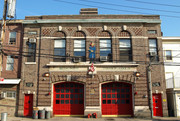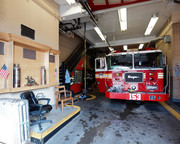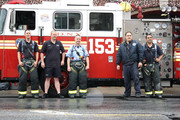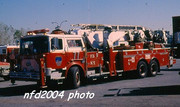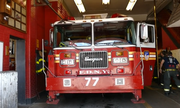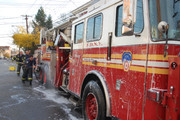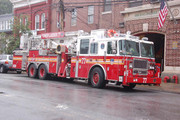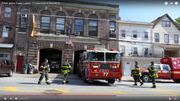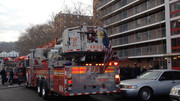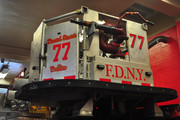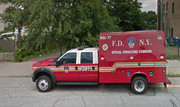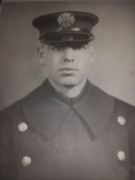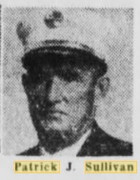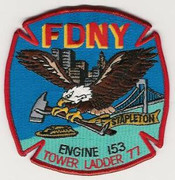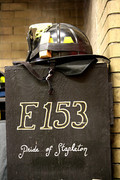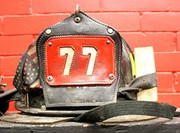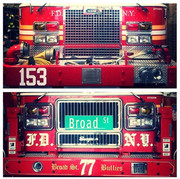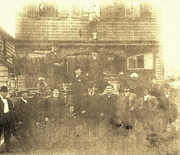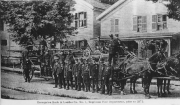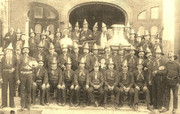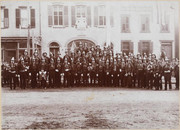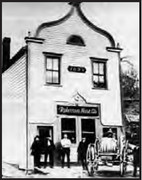Engine 240/Battalion 48 Firehouse 1309 Prospect Avenue, Windsor Terrace, Brooklyn 11th Division, 48th Battalion ?The Road Runners?
Engine 40 BFD organized w/Ladder 21 BFD 1309 Prospect Avenue 1896
Engine 40 BFD became Engine 40 FDNY 1898
Engine 40 became Combined Engine Company 40 1898
Combined Engine Company 40 became Combined Engine Company 140 1899
Combined Engine Company 140 became Combined Engine Company 240 1913
Combined Engine Company 240 became Engine 240 1914
Ladder 21 BFD organized w/Engine 40 BFD 1309 Prospect Avenue w/Engine 40 BFD 1896
Ladder 21 BFD became Ladder 21 FDNY 1898
Ladder 21 disbanded 1898
Battalion 38 organized 395 4th Avenue at Engine 139 1906
Battalion 38 became Battalion 48 1906
Battalion 48 moved 530 11th Street at Engine 220 1930
Battalion 48 moved 1309 Prospect Avenue at Engine 240 1978
Hydrant Service 12 organized 126 Foster Avenue at Engine 250 1934
Hydrant Service 12 moved 1309 Prospect Avenue at Engine 240 1948
Hydrant Service 12 moved 126 Foster Avenue at Engine 250 1951
Hydrant Service 12 disbanded 1957
Pre-BFD:
Windsor Terrace Hose Company No. 3 was formed in January 1888 to protect the growing community of Windsor Terrace. It was consolidated with the Washington Engine Company and the Melrose and Woodbine fire companies of Parkville to form the Flatbush Fire Department. The firehouse was located at 1286 Prospect Avenue. Windsor Terrace Hose Company No 3 had about 40 members. The Windsor Hose Company was mustered out of duty when the new firehouse for Brooklyn Fire Department Engine Company 40 was completed and City of Brooklyn assumed responsibility for paid fire-fighting companies in the area.

Brooklyn Fire Department 1309 Prospect Avenue firehouse - Engine 40/Ladder 21:
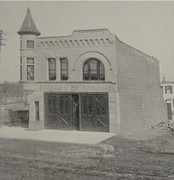
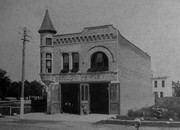
The firehouse for Engine Company 40/ Hook & Ladder Company 21 was put into service in January 20, 1896. It was manned with experienced officers from several different Brooklyn fire companies; several of the firefighters were from former Flatbush volunteer companies. Engine 40 was equipped with a new 1895 Lafrance steamer and an 1896 P.J. Barrett hose wagon; the ladder company was equipped with an 1896 Holloway 50 foot City Service ladder truck with a 40 gallon chemical tank. The Engine Company fought its first fire at 53rd Street and Third Avenue on January 29, 1896. In February 1896, both Engine Company 40 and Ladder Company 21 were called to a fire in a three story frame building on Seeley Street, in Windsor Terrace.
- Landmarks Preservation Commission February 12, 2013 http://www.neighborhoodpreservationcenter.org/db/bb_files/2013-FirehouseEngineCompany40Company21.pdf
FDNY 1308 Prospect Avenue firehouse - Engine 240/Battalion 48:
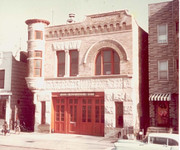
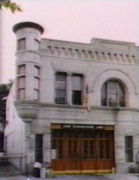

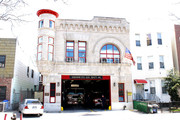


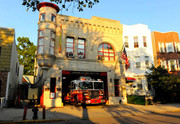



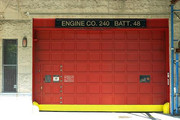
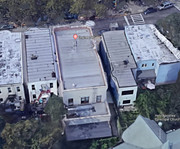
Engine 240:
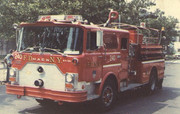
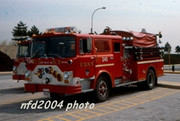

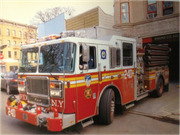
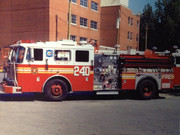

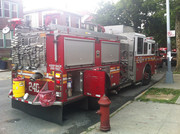

Battalion 48:
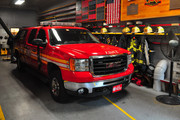
Engine 240 responding:
https://www.youtube.com/watch?v=ieAr3QDJaO4
Engine 240/Battalion 48 LODDs:
FIREFIGHTER EDWARD D. LAHEY ENGINE 240 September 25, 1907

FF Lahey fell from Engine 240's tender while responding to a fire.
BATTALION CHIEF JOHN J. DOOLEY BATTALION 48 June 6, 1931

Battalion Chief John J. Dooley of the 48th Battalion was sliding the pole from the third floor to the second floor when he lost his grip and fell. He fractured his skull in the fall. After a time in the hospital he returned home and then back to the hospital suffering from pneumonia. A member of the old Brooklyn Fire Department since October 15, 1887, he was promoted to Captain on July 1, 1889. A Battalion Chief since 1922 he had been in command of Battalion 48 for the last five years. The fifty-year veteran was married and had one son and was seventy-one years old at the time of his death. - "The Last Alarm" by Boucher, Urbanowicz & Melahn
FIREFIGHTER THOMAS J. OSBORN ENGINE 240 March 3, 1941

Fireman Thomas J. Osborn died on March 3, 1941. He was performing house watch in quarters on the night tour. He complained of being ill to his officer and was ordered to bed. Shortly later, Box 2514 was received and Fireman Osborn responded to the apparatus floor. Not being assigned to the box, he went back to bed. At 9:45, he was found not breathing in his bed. He had died from a heart attack. He left a wife and two children. (From "The Last Alarm" by Boucher, Urbanowicz & Melahn, 2007
FIREFIGHTER EUGENE F. KELLY ENGINE 240 March 22, 1943

FF Eugene Kelly was killed when a trolley struck Engine 240 while responding to a fire.
LIEUTENANT JOHN A. LYDEN ENGINE 240 December 24, 1949



LT John Lyden was overcome by smoke fighting a fire at 324 Church Avenue.
FIREFIGHTER JOSEPH J. TUCKER ENGINE 240 December 19, 1957
FF Joseph J. Tucker was injured fighting a fire. He retired on disability on July 4, 1956 and died from his injury on Dec. 19, 1957.
FIREFIGHTER MICHAEL BOCCHINO BATTALION 48 September 11, 2001
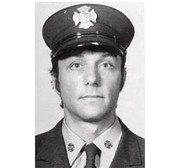
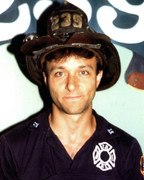
https://www.firehero.org/fallen-firefighter/michael-l-bocchino/
BATTALION CHIEF JOSEPH GRZELAK BATTALION 48 September 11, 2001
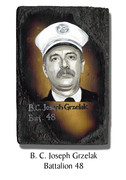
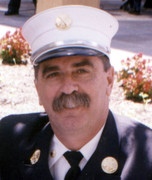
http://www.silive.com/september-11/index.ssf/2010/09/joseph_grzelak_52_fdny_battali.html
http://www.legacy.com/sept11/story.aspx?personid=146335
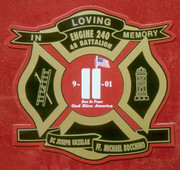
RIP. Never forget.
Engine 240 history: "WINDSOR TERRACE AND ENGINE 240" - Mike Boucher
Engine 240 was placed in service on January 20, 1896. At that time it was not part of the F.D.N.Y. and the fire truck was not painted white over red or diesel powered. One hundred years ago the apparatus was pulled buy a team of horses and was painted a two tone green. Engine 240 was called Engine 40 back then and was part of the City of Brooklyn, the fourth largest city in the country. The village of Windsor Terrace was a farm that belong to John Vanderbilt. He sold the farm to developers in 1849 and the village was formed in 1851. Between 1851 and 1888 there was no fire protection in the village. On January 11 of that year, a fire company was placed in service at 1288 Prospect Avenue and it was called Windsor Terrace Hose 3. They affiliated with the Flatbush Fire Department which was located to the south of Windsor Terrace. The town of Flatbush was annexed by the City of Brooklyn on April 24, 1894 along with Windsor Terrace. The Brooklyn Fire Department kept the volunteers active until the City could build fire stations, buy equipment and hire manpower. For their services, each of the volunteer fire companies were paid $1,000.00 a year. The Flatbush Department had one engine, five hose companies and three ladder companies.
The Brooklyn Fire Department had to hire members from the Flatbush Department to man the new companies. Over three hundred members belong to the Flatbush Department, but only forty four could be pick. Of the forty four picked, thirty two were Republicans. The reason thirty two Republicans were picked is because that is all that was on the department. Flatbush was a Democratic strong, while the City of Brooklyn was Republican. One member of the Hose Company 3 was assigned to Engine 40.
The first members of the company were; Foreman James Cummings and Assistant Foreman George H. Fletcher came from other Brooklyn companies. The members from the Flatbush companies were; Thomas F. Regin, William Gremeler, Douglas Murray, John Levanion, Walter T. Tibball, Henry Dorsch, Thomas Gorman, Anton Newman, Enos Pierson, John A. Boddy, Peter J. Velia, J. J. Mctigue and Frederick Meyer. Fireman Walter T. Tibball belonged to Hose Company 3.
Engine 40 and Ladder 21 were organized on the same day along with Engine 48 and Ladder 22 in Flatbush, Engine 49 and Ladder 23 in Midwood, and Engine 50 and Ladder 20 in Parkville. A lot was purchased from Anna M. Ferris on April 1, 1895 for a cost of $1,600.00. The lot measured 40 feet in the front and 100 feet deep. Engine 40 and Ladder 21 moved into the newly built firehouse on Prospect Avenue near the corner of Greenwood Avenue. New apparatus was assigned to the company, Engine 40 received a 1895 Lafrance 4th size (300 to 500 gpm) steamer, 1896 P. J. Barrett hose wagon and a 1896 Holloway 50 foot City Service Ladder truck with a 40 gallon chemical tank.
The two bay, two story house was built by J. T. Lauretzen for a cost of $15,600.00. The front of the building which measures 32 feet across has a Romanesque style, using Wyoming blue stone, Indiana limestone and gray pressed brick. On the left side is a circular tower supported on a richly carved cobble of limestone. The cornice is made of brick in an ornamental pattern. The two apparatus doors are rich in details with the frame work highly ornamental. The first floor has room for a steam fire engine, hose wagon and ladder truck. In the rear six stalls were provided for the horses and behind the stalls was a one story room for the feed and supplies for the horses, now the kitchen. The on left side in the front is the raised platform for the house watch and on the right side are hose racks, which can hold 700 feet of hose. The second floor has a sitting room, and an engineer room in the front, a dormitory with twelve beds, the foreman and assistant foreman's room in the back, and a general toilet room.
Prior to 1896, the fire department always boasted of the latest and most modern convinces and comforts for the men. With these new houses a new feature was added for the comfort of the men, a water heater for hot water. Now the men could take a hot bath after a fire. In the 1896 Annual Report it was reported "... to have the convenience of taking a refreshing bath, without the risk or danger of taking cold, which was the case in former years, when only cold water was obtainable."
A fireman did not have worry about finding a mutual partner or wonder "do I go to work today". The work schedule was very simple, 24 hours a day, 6 days on and the seventh day off. Each fireman could go home twice a day for two hours for meals. The assistant foreman and the engineer could also be detailed to a neighboring company to cover meals at that house. A fireman could also be detail to another firehouse for a 24 hour period to cover vacancies. The paid was a little over $1,000.00 a year, or thirteen and half cents an hour for a 144 hour week.
The Cities of New York (including the Bronx), Brooklyn, Long Island City, parts of Western Queens, and Staten Island merged into the five Boroughs of New York City on January 1, 1898. Engine 40 and Ladder 21 officially became part of the F.D.N.Y. on January 28th. On April 15, 1898 Ladder 21 was disbanded as a separate fire company and the ladder truck assigned to Engine 40 to make it a combination company of an engine, hose wagon, and ladder truck.
On October 1, 1899 Engine 40 was renumber to Engine 140 to avoid confusion with Engine 40 in Manhattan. Engine 140 would last only to January 1, 1913 and after this date it would be called Engine 240. Combination Engine 240 status was changed on May 15, 1914 when it lost the ladder truck. Ladder 147 and Ladder 148 were placed in service in neighboring firehouse. The two motorized rigs replaced the three horse drawn ladder trucks at Engines 240, 248 and 250.
The fire horse would be given a high place in fire service history. They were treated better than the men and were well taken care of. The department had an ambulance to take the horses to hospital when hurt or sick, before the fire department had an ambulance for the men. The also received vacations before the men. The old timers would say that the horses were smart, some of the horses could count the box numbers when the bells sounded and knew which box they responded on. After a fire on a cold snowy winters night, the horses would come back to the firehouse and the firemen would dry the horses, feed them and brush them down, then the men could take a hot bath, change clothes and warm up. The up keep on the horse for one year was around $800.00 a year, a new motor operated apparatus cost $64.00 for fuel. The pasting of the horses in most companies spelled the end of the fire department.
Engine 240 lost its horses on October 21, 1921 when they received a new American LaFrance 700 gpm pumper. The 1896 hose wagon was replaced in 1909 with a new Seagrave hose wagon. When the new LaFrance pumper arrived the hose wagon was not replaced until December 12, 1925 with a used 1914 Mack/Boyd hose wagon from Engine 255. The 1921 American LaFrance was replaced on June 26, 1936 with new LaFrance, 1923 model from Engine 11. This rig also could pump 700 gpm. On November 2, 1946 a new Ward LaFrance 750 gpm pumper replaced the 1923 model. The '46 LaFrance cost $9,700.00 new. The company received another new Ward LaFrance 750 gpm pumper on January 22, 1954. The price had increased to $14,405.00. In 1970 the company was assigned two different Mack pumpers, the first was a used 1965 Mack that came from Engine 225 on January 1, 1970 and was kept until June 12, 1970. The second rig was a new 1970 Mack pumper that could pump 1000 gallons of water per minute. Another 1970 Mack was delivered on Feb. 21, 1980 and used until August 8, 1980 at which time a new 1979 Mack was received. The current rig is a 1989 Mack that replaced the 1979 model on December 13, 1989.
By the mid 1920's the firehouse was starting to show it age. The new rigs were getting wider than the horse drawn apparatus and the doors were narrow. On November 20, 1925, $10,000.00 allocated for the repairs of quarters, new apparatus doors, removing the roof of the tower and other general repairs. Before the work could be started some emergency work to one of the fireboats postponed the work for a lack of funds. In March of 1926 new bids were received for the work. The bids ranged from $13,210.00 to $24,184.00. The $13,210.00 bid won the contract and the work was completed during 1926.
Beside Engine 240, the firehouse on Prospect Avenue has housed several other pieces of apparatus. Division 12 relocated on November 1, 1948 and Hydrant Service Unit 4 moved in on December 12, 1948. Both of these moves were temporary for some work being done in from Engine 250's quarters, While at Engine 240 the Hydrant Service 4 was renumber to #12 on April 18, 1949. Both units moved back to Engine 250's quarters on February 6, 1951 for the Division and February 9th for the Hydrant Service 12.
Today Engine 240 shares it quarters with the 48th Battalion. The Battalion moved into quarters on October 19, 1978. Battalion 38 was organized on April 1, 1906 at Engine 139 (now E-239) quarters on 4th Avenue and 6th Street. On April 15, 1906 the 38 Battalion was renumber to the 48 Battalion. The 10th Division was reorganized on January 1, 1930, in Engine 239's quarters and the 48th Battalion moved to Engine 220's quarters on 11th Avenue between 8th & 7th Avenues. In 1978 to Engine 240.
The fireman performs his job in the most hazardous of conditions, Most jobs a person knows he'll be home at the end of his shift but, not a fireman, he could have been hurt and in the hospital. Even worst he could lose his life. In the history of the New York City Fire Department 776 members have lost their lives. Five members of Engine 240 have paid that supreme price with their life.
Engine 140 was responding to fire on 56th Street and 12th Avenue in Borough Park on September 20, 1907. Fireman Edward D. Lahey was reaching for his boots when the hose wagon made a sharp turn from E. 3rd Street on to Ft. Hamliton Parkway throwing him off of the rig. He landed on his head, fracturing his skull and he lost consciousness. He died on September 25, never regaining consciousness. He was single and 27years old.
Fireman Thomas J. Osborn died on March 3, 1941. He was performing house watch in quarters on the night watch. He complained of be ill to his officer and was ordered to bed. Shortly Signal Station 2514 was received and Fireman Osborn responded to the apparatus floor, not being assigned to the box he went back to bed. At 9:45 he was found not breathing in his bed. He had died from a heart attack. He left a wife and two children.
Fireman Eugene F. Kelly and Fireman Robert W. Lane of Ladder 105, who were detailed to the company for the day, were injured on March 20, 1943. The company was responding to a automobile fire at Bedford Avenue and Hawthrone Street. Traveling north on Flatbush Avenue, a southbound trolley car sideswiped the apparatus throwing the six fireman to the street. Firemen Kelly and Lane received severe brain injuries in the accident. Fireman Kelly died two days later of his injury, and Fireman Lane died on April 9.
Lieutenant John A. Lyden was overcome by smoke while fighting a fire in a row of taxpayers on December 23, 1949 . The fire at 324 through 328 Church Avenue was confined to the first floors of the three buildings and was label arson. He died shortly after reaching the hospital. He was 49 years old and left a wife.
The last member to died was Fireman Joseph J. Tucker. He was hurt at fire. He retired on disability on July 4, 1956 and died from his injury on Dec. 19, 1957.
Engine 240 is ready for any type of emergency, fire, water leak, EMS or just to pump air in a kid's bicycle tire. Engine 240 has been serving the citizens of Windsor Terrace and the rest of New York for 100 years and will continue serving the public no matter what part of the City it is, Brooklyn, Manhattan Queens, The Bronx or Staten Island, Engine 240 will be there.
THE APPARATUS OF ENGINE 240
1895 HORSE DRAWN LAFRANCE 4TH SIZE STEAMER #334 JAN. 20, 1896-OCT. 21, 1921
1896 P. J. BARRETT HOSE WAGON JAN, 20, 1896-1909
1896 HOLLOWAY COMBINATION C.S.T. 50' #8B JAN, 20, 1896-APR. 15, 1914
1909 SEAGRAVE HOSE WAGON #129B 1909-OCT. 21, 1921
1921 MOTORIZED APPARATUS 1921 AMERICAN LAFRANCE 700 GPM #3580 OCT. 21, 1921-JUN. 6, 1936
1923 AMERICAN LAFRANCE 700 GPM #4273 JUN. 6, 1936-NOV. 22, 1946
1946 WARD LAFRANCE 750 GPM #2199 NOV. 22, 1946-JAN. 22, 1954
1953 WARD LAFRANCE 750 GPM #3301 JAN. 22, 1954-JAN. 9, 1970
1965 MACK 1000 GPM #1318 JAN. 9, 1970-JUN. 12, 1970
1970 MACK 1000 GPM #MP7073 JUN. 12, 1970-FEB. 21, 1980
1970 MACK 1000 GPM #MP7045 FEB. 21, 1970-AUG. 8, 1980
1979 MACK 1000 GPM #MP7954 AUG. 8, 1980-DEC. 13, 1989
1989 MACK 1000 GPM #MP8908 DEC. 13, 1989-PRESENT
Engine 240 -Department Orders:
--------------------------------------------------------------------------------------------------------------------------------------------
FIRE DEPARTMENT CITY OF NEW YORK BOROUGHS OF BROOKLYN & QUEENS
_____________
SPECIAL ORDER No 114 New York September 25, 1907
___________________________________________
1 With feelings of the of the deepest regret the death of Fireman 1st grade Edward D. Leahey of Engine Co. 140, who died from injuries received while responding with his company to a fire at 56th Street & 12th Avenue, Borough of Brooklyn on September 20th, 1907, Station 2-463 is hereby announced to the Department. The Department mourns the loss of this brave fireman from its ranks and extends its most heartfelt sympathy to the relatives and friends of the deceased in the sad loss which has so suddenly befallen them.
The funeral escort will consist of one company of the men composed of two fireman each from the 31st, 32nd, 33rd and 38th Battalions under the command of Asst. Foreman Dennis McAuly, Engine 136. The members of Engine Co. 140 will act as pallbearers and mourners. The funeral will take place from his late residence No. 455 5th Street, Borough of Brooklyn, at 9:30 A. M. sharp on the 28th instant, thence to the Church of St. Saviour, Cor. 6th St. and 8th Avenue. Interment in Calvary Cemetery.
- - - - - - - - - - - - - - - - - - - - - - - - - - - - - - - - - - - - - - - - - - - - - - - - - - - - - - - - - - - - - - - - - - - - - - - - - -
HEADQUARTERS FIRE DEPARTMENT CITY OF NEW YORK
_____________ SPECIAL ORDER New York, March 5, 1941 No. 44
___________________________________________
1 With regret, the death of Fireman 1st grade Thomas J. Osborn, Engine Co. 240, which occurred at 11.40 P. M., March 3, 1941, is hereby announced to the department.
Funeral will take place from the Duffy Funeral pallor, 237 Ninth Street, Borough of Brooklyn, at 9.30 A. M., Thursday, March 6, 1941. Interment at Holy Cross Cemetery, Brooklyn.
The Deputy Chief of the 10th Division shall detail one Lieutenant and twelve Fireman, who, together with six Members from the off platoon of Engine Co. 240 (who shall act as pallbearers), shall report, in full uniform, at the quarters of Engine Co. 239, at 9.15 A. M. on the 6th inst., proceed to the above-mentioned funeral parlor, thence to the Church of St. Thomas Aquinas, 9th Street and 4th Avenue, Borough of Brooklyn, and after the service, shall accompany the remains a reasonable distance, when detail shall be dismissed.
---------------------------------------------------------------------------------------------------------------------------
HEADQUARTERS FIRE DEPARTMENT CITY OF NEW YORK _____________ SPECIAL ORDER New York, March 24, 1943 No. 65 ___________________________________________
1 With regret, the death of Fireman 1st grade Eugene F. Kelly, of Engine Co. 240, which occurred at 6.55 P. M., March 22, 1943, from Fracture of the skull and Lacerations of the brain, caused by and introduced in the performance of duty, while responding to Signal Station 1091, at 7.50 P. M., March 20, 1943, is hereby announced to the Department.
The heartfelt sympathy of the entire Department goes out to the family, relatives and friends of the deceased in the midst of the great loss which they and the Department have sustained.
Funeral will take place from the Funeral Home of Walter B. Cooke, Inc., 1218 Flatbush Avenue, Borough of Brooklyn, at 9.30 A. M., Friday, March 26, 1943. Interment Calvary Cemetery.
- - - - - - - - - - - - - - - - - - - - - - - - - - - - - - - - - - - - - - - - - - - - - - - - - - - - - - - - - - -
HEADQUARTERS FIRE DEPARTMENT CITY OF NEW YORK _____________ SPECIAL ORDER New York, December 27, 1949 No. 217 ___________________________________________
1 With regrets, the death of Lieutenant John A. Lyden, of Engine Co. 240, which occurred at 12.20 A. M., December 24, 1949, from injuries sustained in the performance of duty while operating at Signal Station 3775, Brooklyn, received at 11.54 P. M., December 23, 1949, is hereby announced to the Department.
The heartfelt sympathy of the entire Department goes out to the family, relatives and friends of the deceased in the midst of the great loss which they and the Department have sustained.
The funeral will take place from Walter B. Cooke Funeral Home, 20 Snyder Avenue, Borough of Brooklyn, at 9.30 A. M., Tuesday, December 27, 1949. Interment at Holy Cross Cemetery. -
- - - - - - - - - - - - - - - - - - - - - - - - - - - - - - - - - - - - - - - - - - - - - - - - - - - - - - - - - - - -
HEADQUARTERS FIRE DEPARTMENT CITY OF NEW YORK UNIFORMED FORCE
DEPARTMENT New York, December 20, 1957 ORDER No. 232 ___________________________________________
1.1 With regret, the death of retired Fireman Joseph J. Tucker, formerly of Engine 240, residing at 1485 East 52nd Street, Brooklyn, N.Y., which occurred on December 19, 1957, is hereby announced to the Department.
Funeral will take place from the Michael J. Smith Funeral Home, 248 Prospect Park West, Brooklyn, N.Y., on December 21, 1957, followed by a 9>30 A. M. Requiem Mass at Holy Name R. C. Church, 245 Prospect Park West, Brooklyn, N.Y. Interment at Holy Cross Cemetery.
- http://nyfd.com/brooklyn_engines/engine_240/engine_240.pdf
Windsor Terrace:
http://forgotten-ny.com/2007/03/windsor-terrace-brooklyn/


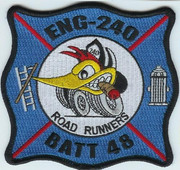
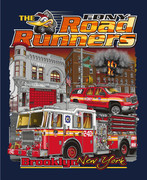
Engine 40 BFD organized w/Ladder 21 BFD 1309 Prospect Avenue 1896
Engine 40 BFD became Engine 40 FDNY 1898
Engine 40 became Combined Engine Company 40 1898
Combined Engine Company 40 became Combined Engine Company 140 1899
Combined Engine Company 140 became Combined Engine Company 240 1913
Combined Engine Company 240 became Engine 240 1914
Ladder 21 BFD organized w/Engine 40 BFD 1309 Prospect Avenue w/Engine 40 BFD 1896
Ladder 21 BFD became Ladder 21 FDNY 1898
Ladder 21 disbanded 1898
Battalion 38 organized 395 4th Avenue at Engine 139 1906
Battalion 38 became Battalion 48 1906
Battalion 48 moved 530 11th Street at Engine 220 1930
Battalion 48 moved 1309 Prospect Avenue at Engine 240 1978
Hydrant Service 12 organized 126 Foster Avenue at Engine 250 1934
Hydrant Service 12 moved 1309 Prospect Avenue at Engine 240 1948
Hydrant Service 12 moved 126 Foster Avenue at Engine 250 1951
Hydrant Service 12 disbanded 1957
Pre-BFD:
Windsor Terrace Hose Company No. 3 was formed in January 1888 to protect the growing community of Windsor Terrace. It was consolidated with the Washington Engine Company and the Melrose and Woodbine fire companies of Parkville to form the Flatbush Fire Department. The firehouse was located at 1286 Prospect Avenue. Windsor Terrace Hose Company No 3 had about 40 members. The Windsor Hose Company was mustered out of duty when the new firehouse for Brooklyn Fire Department Engine Company 40 was completed and City of Brooklyn assumed responsibility for paid fire-fighting companies in the area.

Brooklyn Fire Department 1309 Prospect Avenue firehouse - Engine 40/Ladder 21:


The firehouse for Engine Company 40/ Hook & Ladder Company 21 was put into service in January 20, 1896. It was manned with experienced officers from several different Brooklyn fire companies; several of the firefighters were from former Flatbush volunteer companies. Engine 40 was equipped with a new 1895 Lafrance steamer and an 1896 P.J. Barrett hose wagon; the ladder company was equipped with an 1896 Holloway 50 foot City Service ladder truck with a 40 gallon chemical tank. The Engine Company fought its first fire at 53rd Street and Third Avenue on January 29, 1896. In February 1896, both Engine Company 40 and Ladder Company 21 were called to a fire in a three story frame building on Seeley Street, in Windsor Terrace.
- Landmarks Preservation Commission February 12, 2013 http://www.neighborhoodpreservationcenter.org/db/bb_files/2013-FirehouseEngineCompany40Company21.pdf
FDNY 1308 Prospect Avenue firehouse - Engine 240/Battalion 48:












Engine 240:








Battalion 48:

Engine 240 responding:
https://www.youtube.com/watch?v=ieAr3QDJaO4
Engine 240/Battalion 48 LODDs:
FIREFIGHTER EDWARD D. LAHEY ENGINE 240 September 25, 1907

FF Lahey fell from Engine 240's tender while responding to a fire.
BATTALION CHIEF JOHN J. DOOLEY BATTALION 48 June 6, 1931

Battalion Chief John J. Dooley of the 48th Battalion was sliding the pole from the third floor to the second floor when he lost his grip and fell. He fractured his skull in the fall. After a time in the hospital he returned home and then back to the hospital suffering from pneumonia. A member of the old Brooklyn Fire Department since October 15, 1887, he was promoted to Captain on July 1, 1889. A Battalion Chief since 1922 he had been in command of Battalion 48 for the last five years. The fifty-year veteran was married and had one son and was seventy-one years old at the time of his death. - "The Last Alarm" by Boucher, Urbanowicz & Melahn
FIREFIGHTER THOMAS J. OSBORN ENGINE 240 March 3, 1941

Fireman Thomas J. Osborn died on March 3, 1941. He was performing house watch in quarters on the night tour. He complained of being ill to his officer and was ordered to bed. Shortly later, Box 2514 was received and Fireman Osborn responded to the apparatus floor. Not being assigned to the box, he went back to bed. At 9:45, he was found not breathing in his bed. He had died from a heart attack. He left a wife and two children. (From "The Last Alarm" by Boucher, Urbanowicz & Melahn, 2007
FIREFIGHTER EUGENE F. KELLY ENGINE 240 March 22, 1943

FF Eugene Kelly was killed when a trolley struck Engine 240 while responding to a fire.
LIEUTENANT JOHN A. LYDEN ENGINE 240 December 24, 1949



LT John Lyden was overcome by smoke fighting a fire at 324 Church Avenue.
FIREFIGHTER JOSEPH J. TUCKER ENGINE 240 December 19, 1957
FF Joseph J. Tucker was injured fighting a fire. He retired on disability on July 4, 1956 and died from his injury on Dec. 19, 1957.
FIREFIGHTER MICHAEL BOCCHINO BATTALION 48 September 11, 2001


https://www.firehero.org/fallen-firefighter/michael-l-bocchino/
BATTALION CHIEF JOSEPH GRZELAK BATTALION 48 September 11, 2001


http://www.silive.com/september-11/index.ssf/2010/09/joseph_grzelak_52_fdny_battali.html
http://www.legacy.com/sept11/story.aspx?personid=146335

RIP. Never forget.
Engine 240 history: "WINDSOR TERRACE AND ENGINE 240" - Mike Boucher
Engine 240 was placed in service on January 20, 1896. At that time it was not part of the F.D.N.Y. and the fire truck was not painted white over red or diesel powered. One hundred years ago the apparatus was pulled buy a team of horses and was painted a two tone green. Engine 240 was called Engine 40 back then and was part of the City of Brooklyn, the fourth largest city in the country. The village of Windsor Terrace was a farm that belong to John Vanderbilt. He sold the farm to developers in 1849 and the village was formed in 1851. Between 1851 and 1888 there was no fire protection in the village. On January 11 of that year, a fire company was placed in service at 1288 Prospect Avenue and it was called Windsor Terrace Hose 3. They affiliated with the Flatbush Fire Department which was located to the south of Windsor Terrace. The town of Flatbush was annexed by the City of Brooklyn on April 24, 1894 along with Windsor Terrace. The Brooklyn Fire Department kept the volunteers active until the City could build fire stations, buy equipment and hire manpower. For their services, each of the volunteer fire companies were paid $1,000.00 a year. The Flatbush Department had one engine, five hose companies and three ladder companies.
The Brooklyn Fire Department had to hire members from the Flatbush Department to man the new companies. Over three hundred members belong to the Flatbush Department, but only forty four could be pick. Of the forty four picked, thirty two were Republicans. The reason thirty two Republicans were picked is because that is all that was on the department. Flatbush was a Democratic strong, while the City of Brooklyn was Republican. One member of the Hose Company 3 was assigned to Engine 40.
The first members of the company were; Foreman James Cummings and Assistant Foreman George H. Fletcher came from other Brooklyn companies. The members from the Flatbush companies were; Thomas F. Regin, William Gremeler, Douglas Murray, John Levanion, Walter T. Tibball, Henry Dorsch, Thomas Gorman, Anton Newman, Enos Pierson, John A. Boddy, Peter J. Velia, J. J. Mctigue and Frederick Meyer. Fireman Walter T. Tibball belonged to Hose Company 3.
Engine 40 and Ladder 21 were organized on the same day along with Engine 48 and Ladder 22 in Flatbush, Engine 49 and Ladder 23 in Midwood, and Engine 50 and Ladder 20 in Parkville. A lot was purchased from Anna M. Ferris on April 1, 1895 for a cost of $1,600.00. The lot measured 40 feet in the front and 100 feet deep. Engine 40 and Ladder 21 moved into the newly built firehouse on Prospect Avenue near the corner of Greenwood Avenue. New apparatus was assigned to the company, Engine 40 received a 1895 Lafrance 4th size (300 to 500 gpm) steamer, 1896 P. J. Barrett hose wagon and a 1896 Holloway 50 foot City Service Ladder truck with a 40 gallon chemical tank.
The two bay, two story house was built by J. T. Lauretzen for a cost of $15,600.00. The front of the building which measures 32 feet across has a Romanesque style, using Wyoming blue stone, Indiana limestone and gray pressed brick. On the left side is a circular tower supported on a richly carved cobble of limestone. The cornice is made of brick in an ornamental pattern. The two apparatus doors are rich in details with the frame work highly ornamental. The first floor has room for a steam fire engine, hose wagon and ladder truck. In the rear six stalls were provided for the horses and behind the stalls was a one story room for the feed and supplies for the horses, now the kitchen. The on left side in the front is the raised platform for the house watch and on the right side are hose racks, which can hold 700 feet of hose. The second floor has a sitting room, and an engineer room in the front, a dormitory with twelve beds, the foreman and assistant foreman's room in the back, and a general toilet room.
Prior to 1896, the fire department always boasted of the latest and most modern convinces and comforts for the men. With these new houses a new feature was added for the comfort of the men, a water heater for hot water. Now the men could take a hot bath after a fire. In the 1896 Annual Report it was reported "... to have the convenience of taking a refreshing bath, without the risk or danger of taking cold, which was the case in former years, when only cold water was obtainable."
A fireman did not have worry about finding a mutual partner or wonder "do I go to work today". The work schedule was very simple, 24 hours a day, 6 days on and the seventh day off. Each fireman could go home twice a day for two hours for meals. The assistant foreman and the engineer could also be detailed to a neighboring company to cover meals at that house. A fireman could also be detail to another firehouse for a 24 hour period to cover vacancies. The paid was a little over $1,000.00 a year, or thirteen and half cents an hour for a 144 hour week.
The Cities of New York (including the Bronx), Brooklyn, Long Island City, parts of Western Queens, and Staten Island merged into the five Boroughs of New York City on January 1, 1898. Engine 40 and Ladder 21 officially became part of the F.D.N.Y. on January 28th. On April 15, 1898 Ladder 21 was disbanded as a separate fire company and the ladder truck assigned to Engine 40 to make it a combination company of an engine, hose wagon, and ladder truck.
On October 1, 1899 Engine 40 was renumber to Engine 140 to avoid confusion with Engine 40 in Manhattan. Engine 140 would last only to January 1, 1913 and after this date it would be called Engine 240. Combination Engine 240 status was changed on May 15, 1914 when it lost the ladder truck. Ladder 147 and Ladder 148 were placed in service in neighboring firehouse. The two motorized rigs replaced the three horse drawn ladder trucks at Engines 240, 248 and 250.
The fire horse would be given a high place in fire service history. They were treated better than the men and were well taken care of. The department had an ambulance to take the horses to hospital when hurt or sick, before the fire department had an ambulance for the men. The also received vacations before the men. The old timers would say that the horses were smart, some of the horses could count the box numbers when the bells sounded and knew which box they responded on. After a fire on a cold snowy winters night, the horses would come back to the firehouse and the firemen would dry the horses, feed them and brush them down, then the men could take a hot bath, change clothes and warm up. The up keep on the horse for one year was around $800.00 a year, a new motor operated apparatus cost $64.00 for fuel. The pasting of the horses in most companies spelled the end of the fire department.
Engine 240 lost its horses on October 21, 1921 when they received a new American LaFrance 700 gpm pumper. The 1896 hose wagon was replaced in 1909 with a new Seagrave hose wagon. When the new LaFrance pumper arrived the hose wagon was not replaced until December 12, 1925 with a used 1914 Mack/Boyd hose wagon from Engine 255. The 1921 American LaFrance was replaced on June 26, 1936 with new LaFrance, 1923 model from Engine 11. This rig also could pump 700 gpm. On November 2, 1946 a new Ward LaFrance 750 gpm pumper replaced the 1923 model. The '46 LaFrance cost $9,700.00 new. The company received another new Ward LaFrance 750 gpm pumper on January 22, 1954. The price had increased to $14,405.00. In 1970 the company was assigned two different Mack pumpers, the first was a used 1965 Mack that came from Engine 225 on January 1, 1970 and was kept until June 12, 1970. The second rig was a new 1970 Mack pumper that could pump 1000 gallons of water per minute. Another 1970 Mack was delivered on Feb. 21, 1980 and used until August 8, 1980 at which time a new 1979 Mack was received. The current rig is a 1989 Mack that replaced the 1979 model on December 13, 1989.
By the mid 1920's the firehouse was starting to show it age. The new rigs were getting wider than the horse drawn apparatus and the doors were narrow. On November 20, 1925, $10,000.00 allocated for the repairs of quarters, new apparatus doors, removing the roof of the tower and other general repairs. Before the work could be started some emergency work to one of the fireboats postponed the work for a lack of funds. In March of 1926 new bids were received for the work. The bids ranged from $13,210.00 to $24,184.00. The $13,210.00 bid won the contract and the work was completed during 1926.
Beside Engine 240, the firehouse on Prospect Avenue has housed several other pieces of apparatus. Division 12 relocated on November 1, 1948 and Hydrant Service Unit 4 moved in on December 12, 1948. Both of these moves were temporary for some work being done in from Engine 250's quarters, While at Engine 240 the Hydrant Service 4 was renumber to #12 on April 18, 1949. Both units moved back to Engine 250's quarters on February 6, 1951 for the Division and February 9th for the Hydrant Service 12.
Today Engine 240 shares it quarters with the 48th Battalion. The Battalion moved into quarters on October 19, 1978. Battalion 38 was organized on April 1, 1906 at Engine 139 (now E-239) quarters on 4th Avenue and 6th Street. On April 15, 1906 the 38 Battalion was renumber to the 48 Battalion. The 10th Division was reorganized on January 1, 1930, in Engine 239's quarters and the 48th Battalion moved to Engine 220's quarters on 11th Avenue between 8th & 7th Avenues. In 1978 to Engine 240.
The fireman performs his job in the most hazardous of conditions, Most jobs a person knows he'll be home at the end of his shift but, not a fireman, he could have been hurt and in the hospital. Even worst he could lose his life. In the history of the New York City Fire Department 776 members have lost their lives. Five members of Engine 240 have paid that supreme price with their life.
Engine 140 was responding to fire on 56th Street and 12th Avenue in Borough Park on September 20, 1907. Fireman Edward D. Lahey was reaching for his boots when the hose wagon made a sharp turn from E. 3rd Street on to Ft. Hamliton Parkway throwing him off of the rig. He landed on his head, fracturing his skull and he lost consciousness. He died on September 25, never regaining consciousness. He was single and 27years old.
Fireman Thomas J. Osborn died on March 3, 1941. He was performing house watch in quarters on the night watch. He complained of be ill to his officer and was ordered to bed. Shortly Signal Station 2514 was received and Fireman Osborn responded to the apparatus floor, not being assigned to the box he went back to bed. At 9:45 he was found not breathing in his bed. He had died from a heart attack. He left a wife and two children.
Fireman Eugene F. Kelly and Fireman Robert W. Lane of Ladder 105, who were detailed to the company for the day, were injured on March 20, 1943. The company was responding to a automobile fire at Bedford Avenue and Hawthrone Street. Traveling north on Flatbush Avenue, a southbound trolley car sideswiped the apparatus throwing the six fireman to the street. Firemen Kelly and Lane received severe brain injuries in the accident. Fireman Kelly died two days later of his injury, and Fireman Lane died on April 9.
Lieutenant John A. Lyden was overcome by smoke while fighting a fire in a row of taxpayers on December 23, 1949 . The fire at 324 through 328 Church Avenue was confined to the first floors of the three buildings and was label arson. He died shortly after reaching the hospital. He was 49 years old and left a wife.
The last member to died was Fireman Joseph J. Tucker. He was hurt at fire. He retired on disability on July 4, 1956 and died from his injury on Dec. 19, 1957.
Engine 240 is ready for any type of emergency, fire, water leak, EMS or just to pump air in a kid's bicycle tire. Engine 240 has been serving the citizens of Windsor Terrace and the rest of New York for 100 years and will continue serving the public no matter what part of the City it is, Brooklyn, Manhattan Queens, The Bronx or Staten Island, Engine 240 will be there.
THE APPARATUS OF ENGINE 240
1895 HORSE DRAWN LAFRANCE 4TH SIZE STEAMER #334 JAN. 20, 1896-OCT. 21, 1921
1896 P. J. BARRETT HOSE WAGON JAN, 20, 1896-1909
1896 HOLLOWAY COMBINATION C.S.T. 50' #8B JAN, 20, 1896-APR. 15, 1914
1909 SEAGRAVE HOSE WAGON #129B 1909-OCT. 21, 1921
1921 MOTORIZED APPARATUS 1921 AMERICAN LAFRANCE 700 GPM #3580 OCT. 21, 1921-JUN. 6, 1936
1923 AMERICAN LAFRANCE 700 GPM #4273 JUN. 6, 1936-NOV. 22, 1946
1946 WARD LAFRANCE 750 GPM #2199 NOV. 22, 1946-JAN. 22, 1954
1953 WARD LAFRANCE 750 GPM #3301 JAN. 22, 1954-JAN. 9, 1970
1965 MACK 1000 GPM #1318 JAN. 9, 1970-JUN. 12, 1970
1970 MACK 1000 GPM #MP7073 JUN. 12, 1970-FEB. 21, 1980
1970 MACK 1000 GPM #MP7045 FEB. 21, 1970-AUG. 8, 1980
1979 MACK 1000 GPM #MP7954 AUG. 8, 1980-DEC. 13, 1989
1989 MACK 1000 GPM #MP8908 DEC. 13, 1989-PRESENT
Engine 240 -Department Orders:
--------------------------------------------------------------------------------------------------------------------------------------------
FIRE DEPARTMENT CITY OF NEW YORK BOROUGHS OF BROOKLYN & QUEENS
_____________
SPECIAL ORDER No 114 New York September 25, 1907
___________________________________________
1 With feelings of the of the deepest regret the death of Fireman 1st grade Edward D. Leahey of Engine Co. 140, who died from injuries received while responding with his company to a fire at 56th Street & 12th Avenue, Borough of Brooklyn on September 20th, 1907, Station 2-463 is hereby announced to the Department. The Department mourns the loss of this brave fireman from its ranks and extends its most heartfelt sympathy to the relatives and friends of the deceased in the sad loss which has so suddenly befallen them.
The funeral escort will consist of one company of the men composed of two fireman each from the 31st, 32nd, 33rd and 38th Battalions under the command of Asst. Foreman Dennis McAuly, Engine 136. The members of Engine Co. 140 will act as pallbearers and mourners. The funeral will take place from his late residence No. 455 5th Street, Borough of Brooklyn, at 9:30 A. M. sharp on the 28th instant, thence to the Church of St. Saviour, Cor. 6th St. and 8th Avenue. Interment in Calvary Cemetery.
- - - - - - - - - - - - - - - - - - - - - - - - - - - - - - - - - - - - - - - - - - - - - - - - - - - - - - - - - - - - - - - - - - - - - - - - - -
HEADQUARTERS FIRE DEPARTMENT CITY OF NEW YORK
_____________ SPECIAL ORDER New York, March 5, 1941 No. 44
___________________________________________
1 With regret, the death of Fireman 1st grade Thomas J. Osborn, Engine Co. 240, which occurred at 11.40 P. M., March 3, 1941, is hereby announced to the department.
Funeral will take place from the Duffy Funeral pallor, 237 Ninth Street, Borough of Brooklyn, at 9.30 A. M., Thursday, March 6, 1941. Interment at Holy Cross Cemetery, Brooklyn.
The Deputy Chief of the 10th Division shall detail one Lieutenant and twelve Fireman, who, together with six Members from the off platoon of Engine Co. 240 (who shall act as pallbearers), shall report, in full uniform, at the quarters of Engine Co. 239, at 9.15 A. M. on the 6th inst., proceed to the above-mentioned funeral parlor, thence to the Church of St. Thomas Aquinas, 9th Street and 4th Avenue, Borough of Brooklyn, and after the service, shall accompany the remains a reasonable distance, when detail shall be dismissed.
---------------------------------------------------------------------------------------------------------------------------
HEADQUARTERS FIRE DEPARTMENT CITY OF NEW YORK _____________ SPECIAL ORDER New York, March 24, 1943 No. 65 ___________________________________________
1 With regret, the death of Fireman 1st grade Eugene F. Kelly, of Engine Co. 240, which occurred at 6.55 P. M., March 22, 1943, from Fracture of the skull and Lacerations of the brain, caused by and introduced in the performance of duty, while responding to Signal Station 1091, at 7.50 P. M., March 20, 1943, is hereby announced to the Department.
The heartfelt sympathy of the entire Department goes out to the family, relatives and friends of the deceased in the midst of the great loss which they and the Department have sustained.
Funeral will take place from the Funeral Home of Walter B. Cooke, Inc., 1218 Flatbush Avenue, Borough of Brooklyn, at 9.30 A. M., Friday, March 26, 1943. Interment Calvary Cemetery.
- - - - - - - - - - - - - - - - - - - - - - - - - - - - - - - - - - - - - - - - - - - - - - - - - - - - - - - - - - -
HEADQUARTERS FIRE DEPARTMENT CITY OF NEW YORK _____________ SPECIAL ORDER New York, December 27, 1949 No. 217 ___________________________________________
1 With regrets, the death of Lieutenant John A. Lyden, of Engine Co. 240, which occurred at 12.20 A. M., December 24, 1949, from injuries sustained in the performance of duty while operating at Signal Station 3775, Brooklyn, received at 11.54 P. M., December 23, 1949, is hereby announced to the Department.
The heartfelt sympathy of the entire Department goes out to the family, relatives and friends of the deceased in the midst of the great loss which they and the Department have sustained.
The funeral will take place from Walter B. Cooke Funeral Home, 20 Snyder Avenue, Borough of Brooklyn, at 9.30 A. M., Tuesday, December 27, 1949. Interment at Holy Cross Cemetery. -
- - - - - - - - - - - - - - - - - - - - - - - - - - - - - - - - - - - - - - - - - - - - - - - - - - - - - - - - - - - -
HEADQUARTERS FIRE DEPARTMENT CITY OF NEW YORK UNIFORMED FORCE
DEPARTMENT New York, December 20, 1957 ORDER No. 232 ___________________________________________
1.1 With regret, the death of retired Fireman Joseph J. Tucker, formerly of Engine 240, residing at 1485 East 52nd Street, Brooklyn, N.Y., which occurred on December 19, 1957, is hereby announced to the Department.
Funeral will take place from the Michael J. Smith Funeral Home, 248 Prospect Park West, Brooklyn, N.Y., on December 21, 1957, followed by a 9>30 A. M. Requiem Mass at Holy Name R. C. Church, 245 Prospect Park West, Brooklyn, N.Y. Interment at Holy Cross Cemetery.
- http://nyfd.com/brooklyn_engines/engine_240/engine_240.pdf
Windsor Terrace:
http://forgotten-ny.com/2007/03/windsor-terrace-brooklyn/





